The sciences division is the corps of officers and crewmen aboard the Solstice who specialize in scientific research. The Sciences Division uniform features a teal stripe.
Enlisted Crew[]
Crew members of the sciences division may be specialized in a variety of jobs such as:
- Archeologist/Anthropologist
- Astrophysicist
- Biologist
- Chemist
- Probe Technician
- Sensor Technician
- or many other subject area experts.
Officers[]
Officers within this division are mostly scientists working in within their discipline or administrators promoted from the field of subject matter experts. Occasionally a skilled administrator from outside of the sciences might choose to command a science department or be appointed if need be. The Chief of Sciences on the Solstice will be in charge of coordinating primary science missions (often planetary surveys, archaeological surveys, or first contact missions), as well as secondary missions as the opportunity arises (stellar cartography, sub-space studies, and other domain-specific research). Opportunities for command assignments are somewhat limited for sciences officers due to their lack of overall command experience and training Sciences division officers will only take command of the ship in the absence of other senior officers due to such circumstances as an emergency, illness of a commanding officer, or manpower shortages as may occur in wartime or disaster.
Missions[]
The Solstice is equipped to support up to five concurrent research teams. The primary and secondary science missions assigned to these teams will take advantage of the ship as a mobile research platform. Research missions typically include:
- planetary surveys
- stellar mapping
- celelstial observation projects
- interstellar medium studies
- archaeological investigations
- cultural studies.
Secondary mission teams must necessarily focus their work on stars and planets near primary mission sites, but the broad operating range of the Solstice makes this an extraordinary opportunity to study a large number of celestial objects and phenomena. As with other investigation teams, secondary research projects are generally developed by Starfleet researchers, affiliated university, and industrial scientists, then assigned to the Solstice for either short-term or ongoing investigations. Additionally, the Chief of Science aboard the Solstice may initiate secondary research missions as the opportunity or need arises.
Facilities[]

The Nova class starship in extended mission configuration includes facilities to support approximately five specialized mission teams, depending on team sizes and types of investigations being conducted. These facilities include living accommodations for up to 25 scientists, a dedicated astrometics lab, as well as two non-specialized laboratories that can be configured for specific investigator requirements. Additionally, some forty sensor pallet assignments on the lateral arrays are reserved for mission-specific instrumentation, which can be installed and modified as needed.
Similarly, some fifteen instrument mounting positions within the long-range array cluster are available for mission-specific investigations. Each individual research team is responsible for the operation of its own observations and experiments. Because secondary mission investigations are by definition subordinate to primary mission requirements, these teams must remain flexible in their operations.Each team is responsible for providing a regular update of operational preferences to the Operations Division Manager so that daily mission profiles can be designed to satisfy as many departmental needs as possible.